Test – XFX R9 390X Double Dissipation: Specs | Price | CPU | Profitability| Hashrate| best Coins | Config | Advantage (Pros) and Disadvantages (Cons) and other important features that will help you make better decision.
AMD recently offered us its new graphics cards, in addition to the Fury series which is a new architecture associated with HBM memory which I will not give you a speech because you have probably read it 50 times now there are also the ” news ”3xx. As you have certainly already read also this series is often criticized because once again there has been a significant renaming of the old cards, here is a summary table of the 3xx series
Specification: XFX R9 390X Double Dissipation
| Menu | GPU | Transistors (in billions) | ROPs | Calculation units | GPU Frequency / Memory | Memory Capacity | Bus |
|---|---|---|---|---|---|---|---|
| R9 295X | 2x Hawaii | 2 x 6.2 | 2 x 64 | 2 x 2816 | 1018 / 1250 | 2 x 4 GB | 512 bits |
| R9 390X | Grenada | 6.2 | 64 | 2816 | 1050 / 1500 | 8 GB | 512 bits |
| R9 290X | Hawaii | 6.2 | 64 | 2816 | 1000 / 1250 | 4 GB | 512 bits |
| R9 390 | Grenada | 6.2 | 64 | 2560 | 100 / 1250 | 8 GB | 512 bits |
| R9 290 | Hawaii | 6.2 | 64 | 2560 | 947 / 1250 | 4 GB | 512 bits |
| R9 280X | Tahiti | 4.3 | 32 | 2048 | 1000 / 1500 | 3 GB | 384 bits |
| R9 380 | Antigua | 5 | 32 | 1792 | 970 / 1375 | 2 or 4 GB | 256 bits |
| R9 285 | Tonga | 5 | 32 | 1792 | 918 / 1375 | 2 GB | 256 bits |
| R9 280 | Tahiti | 4.3 | 32 | 1792 | 933 / 1500 | 3 GB | 384 bits |
| R9 270X | Pitcairn | 2.8 | 32 | 1024 | 1050 / 1400 | 2 or 4GB | 256 bits |
| R7 370 | Trinidad | 2.8 | 32 | 1024 | 975 / 1400 | 2 or 4 GB | 256 bits |
| R9 270 | Pitcairn | 2.8 | 32 | 1024 | 925 / 1400 | 2 GB | 256 bits |
| R7 265 | Pitcairn | 2.8 | 32 | 1024 | 925 / 1625 | 1 or 2 GB | 128 bits |
| R7 360 | Tobago | 2 | 16 | 768 | 1050 / 1625 | 2 | 128 bits |
As we can see and despite a renaming of the GPU the characteristics are really very close, for example the only differences between the R9 390X and the R9 290X are an increase of 50 Mhz for the GPU, 250 Mhz for the memory and the passage of 4 to 8 GB of memory, nothing that can logically explode the performance, except in a very high resolution like in 4K with a lot of graphics options activated. The other cards in the series are also a half-disguised rename, with the R9 390 replacing the R9 290, the R9 380 replacing the R9 285, the R7 370 replacing the R9 270 and the R7 260 (which was already a rename of the HD 7850) arriving at the bottom of the table. In short, you will understand the performance should not be a good step forward but rather a very small update,
Characteristics
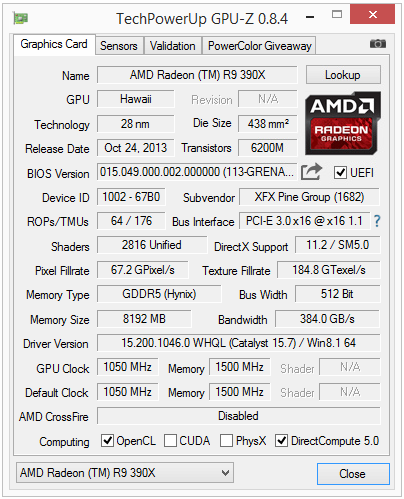
Hashrate – XFX R9 390X Double Dissipation Core Edition
| XFX R9 390X Double Dissipation Core Edition | |
|---|---|
| GPU | Grenada |
| GPU frequency | 1050 MHz |
| Memory Frequency | 1500 Mhz |
| Amount of memory | 8 Go de DDR5 |
| Memory bus | 512 bit |
| Connectivity | 1 x HDMI 1 x DisplayPort 1.2 2 x Dual-Link DVI-D |
| Dimensions | 29.5 x 14.3 x 4.2 cm |
| Food | 1 x 8-pin 1 x 6-pin |
| Price | ~ 490€ |
| Guarantee | 2 years |
The XFX R9 390X Double Dissipation Core Edition is the non-overclocked version from XFX (the “Black Edition” version offers an overclocking of .. 40Mhz to reach 1090MHz for the processor) namely 1050MHz for the processor and 1500MHz for Memory. The 8GB on-board memory will delight people who are looking for a lot of memory to play in 4K, if the card is able to keep pace with the most demanding graphics options.
In terms of dimensions we are in the presence of a beautiful baby with its 29.5cm in length, 14.3cm in height and 4.2cm in thickness, one thing is certain, it will not go unnoticed in the case! Connection side nothing that is out of the
ordinary with 2 DVI-D ports, 1 HDMI port and a DisplayPort 1.2.
Regarding the price on the other hand it increases more compared to the R9 290X which suggests the operating frequencies, when we can find an R9 290X (with an excellent cooling system, like the TriX from Sapphire) at around 350 € the XFX R9 390X 8GB is negotiated at around 490 €, to see if the card is interesting at this price!
Box and bundle
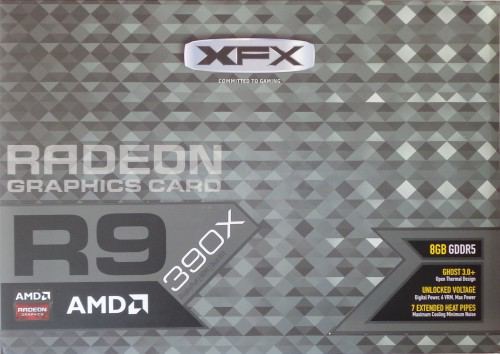
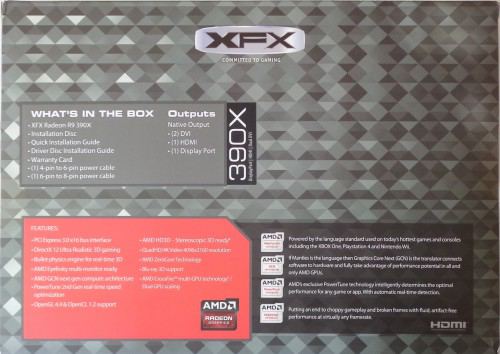
XFX has changed the colors of its boxes, we go from a blue / white for the 2xx series to a mixture of gray for the new cards, at least we will not be able to say that the new ones sting the eyes 😉 On the front face we find the model as well as the amount of memory. At the back a listing of the contents of the box as well as the strengths of the card.
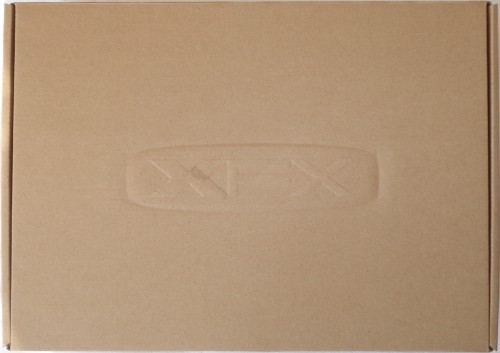
In the box, on the other hand, we are faced with the same packaging as the old cards, namely a cardboard box marked with the brand’s logo.

In this box a compartment for the bundle.
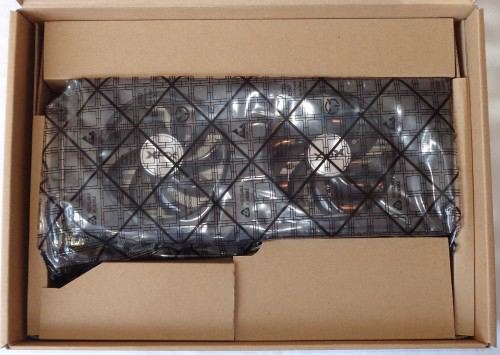
And here is finally the beast! Surrounded by cardboard to avoid as much damage as possible during transport and in its antistatic bag.
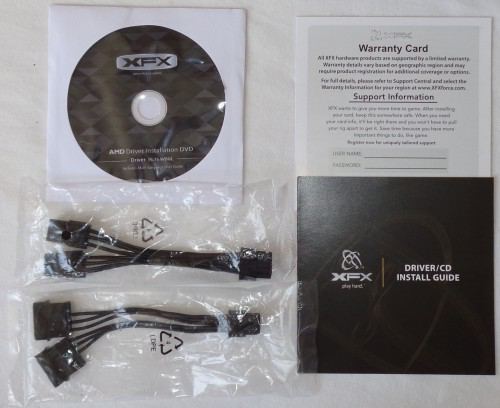
The bundle consists of:
- 1 DVD de drivers
- 1 warranty card
- 1 guide d’installation
- 1 adapter 2 x 6-pin -> 1 x 8-pin
- 1 adapter 2 x 4-pin (molex) -> 1 x 6-pin
We are in the presence of a very classic bundle in terms of graphics cards, in addition to the eternal DVD of drivers and the quick installation guide, adapters could prove useful if ever we run out of connectors (which is not really a good sign on a graphics card that consumes so much by the way!).
The map

Here is the beast! The design changes very little compared to the old R9 290 (see the R9 290 here), we stay on a black plastic casing and 2 fans of 9.2cm, only the logo which was present on the side disappears, to summarize we cannot not to say that XFX is doing extravagance! The beast on the other hand imposes by its size at the level of its length of 29.5 cm but also of its 14.3 cm in height which make it protrude a few centimeters above the PCIe brackets.
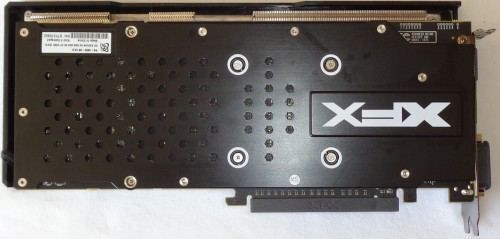
At the rear a metal plate is present in order to hide the components and give a more sympathetic aspect to the whole, some swear by a back plate and XFX has therefore followed the general trend. On the other hand, in addition to the appearance, it will also serve to stiffen the map, which is quite useful when you see the point and the length of the thing.


XFX has dropped the silver border present on the R9 290 but on the other hand put the double plugs on the cooling of the components, as can be seen in the photos in addition to the memory cooling plate the VRM part has a big radiator (which was one of the weak points of the R9 290 that I had put forward).
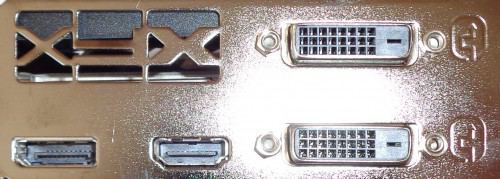
A familiar sight here, 2 DVI ports, 1 HDMI port and 1 DisplayPort port. Some holes are also present for the ventilation of the card, even if in the end the air will be expelled inside the tower.
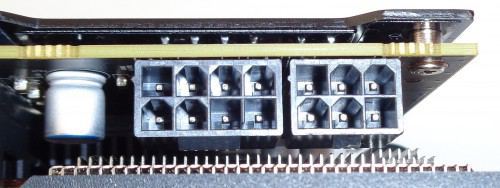
As for the power supply, we are satisfied with an 8-pin connector and a 6-pin connector, rather surprising on a graphics card which is supposed to consume so much, but XFX certainly had to calculate its blow!
We undress the young lady
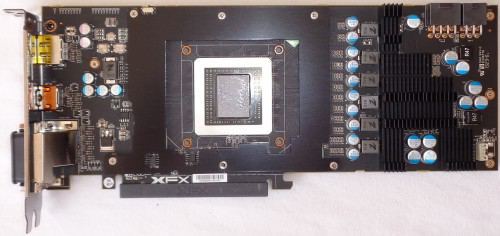
Now one thing is certain, this is indeed the reference PCB of the R9 290 series, there is no longer any doubt about it (see the R9 290 from XFX here). If a change has taken place it has only been at the level of the GPU itself.

We can see that XFX has redesigned the VRM cooling system by offering a large radiator covering a good part of the back of the card. However this can mean several things, either that XFX has indeed taken user / testers feedback into account or that VRMs heat up tremendously and a radiator like this is a necessity, we will see that!
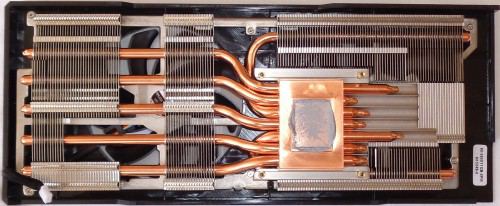
The Double Dissipation cooling system is exactly the same as on the R9 290, with the exception of fins cut above the VRMs so as not to conflict with the radiator of the latter, this will also allow to have l air entering directly for better cooling.
Powertune
With the evolution of Powertune there was a need for a little explanation of why and how, what is Powertune? AMD has introduced a control unit integrated into the GPU which allows certain things to be limited:
- The consumption of the card cannot exceed 208 Watts (as on the R9 290 / 290X) with the original settings
- GPU temperature cannot exceed 95 °
In practice this means that regardless of your overclocking or the conditions of use of the card (very well ventilated case or not) the GPU will not exceed 208Watts and will not exceed 95 °, to do this Powertune comes into play and will automatically reduce GPU frequency to meet one or both of these limitations.
Of course it is possible to override these directives by modifying the settings in Catalyst or any other overclocking software (such as iPower from HIS) of the “Board Power Limit”, going to a maximum of 50% additional in terms of consumption. even though the maximum temperature still remains at 94 °, here is a screenshot from the AMD CCC:
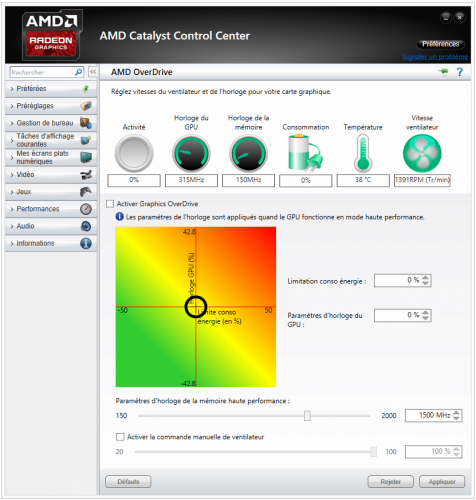
So yes it’s good to be able to adjust the energy consumption limitation but by setting + 50% you have to realize that the card will heat up enormously and therefore reach the 95 ° level very quickly in the event of overclocking with air cooling I would show you in the overclocking section how the GPU frequency suffers.
The test platform
The configuration used during the tests is as follows:
- Processeur: Intel Core i5 4670K @ 4 Ghz
- Motherboard : Gigabyte Z87-UD5H TH
- Mémoire: Kingston HyperX 4 x 2 Go 1600Mhz
- Disque dur: WD Raptor 150 Go
- Power supply : Seasonic X650
- Drivers: Catalyst 14.4 (AMD) & GeForce 337.88 (nVidia)
- Operating system : Windows 8.1 64bits
All games will be tested in 1920 × 1080 detail in full detail (except the TressFX on Tomb Raider), which is the current ‘standard’, graphics cards used in testing are as follows:
- Asus GTX770 DirectCU OC
- HIS R9 290 iPower IceQ X² OC 4GB (testée ici)
- MSI R9 280X Gaming (tested here)
- MSI R9 290 Gaming OC 4GB (tested here)
- Powercolor R9 280X (tested here)
- Sapphire 7950 Dualx @ 900Mhz
- Sapphire 7970 Ghz Edition
- Sapphire R9 280X VaporX Tri-X (tested here)
- XFX R9 280 Double Dissipation (tested here)
- XFX R9 285 Black Edition (tested here)
- XFX R9 290 Double Dissipation (tested here)
Consumption / Temperature
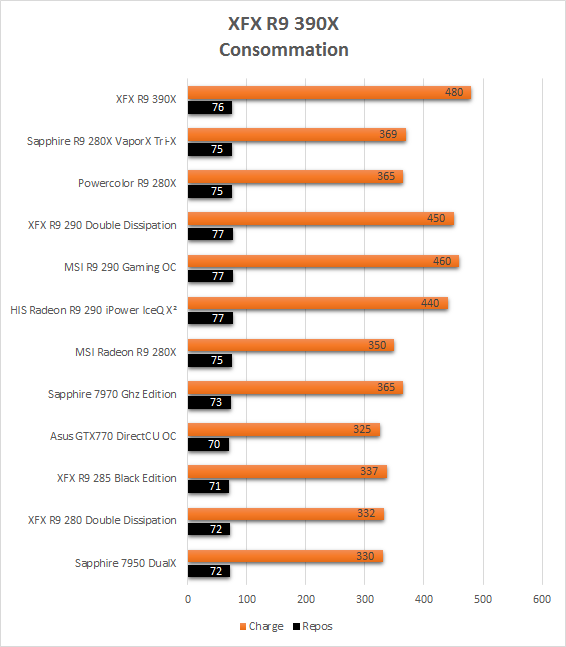
The consumption test was carried out under OCCT Power Supply which makes it possible to push the consumption of the components to the maximum, note that this value reflects the total consumption at the outlet of the machine and not the graphics card itself!
There as it is and without touching the consumption limit, the R9 390X from XFX does not display a much higher consumption than its little sister the R9 290, we still gain 20 Watts by going up to 480 Watts for the configuration. complete, which is still not nothing!
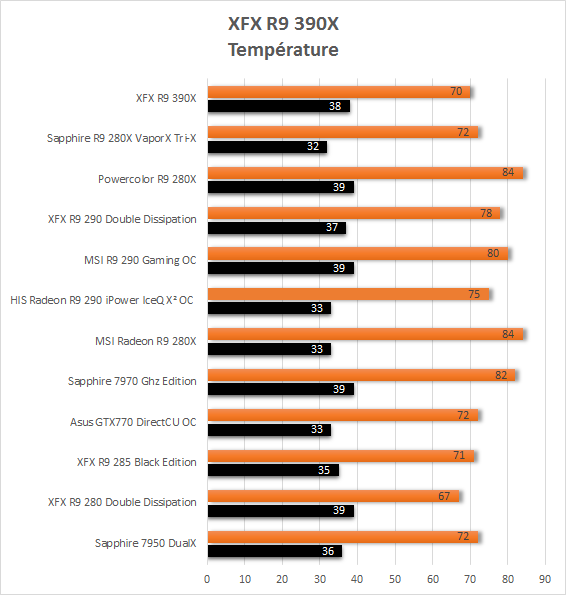
XFX has particularly taken great care to ensure that the temperature of the GPU does not rise excessively, there we arrive at 70 ° from the start when the card is pushed fully (in an open configuration and not in a box). On the other hand, seeing the temperatures and the consumption of the card there are not 36 solutions, either the cooling system is oversized, or the card makes a lot of noise, which we will see immediately!
Sound level
Warning: Part to be taken with a grain of salt, unfortunately not having access to the appropriate equipment and using an android application to take the readings The measurements below are only indicative! The readings were taken 20cm from the graphics card.
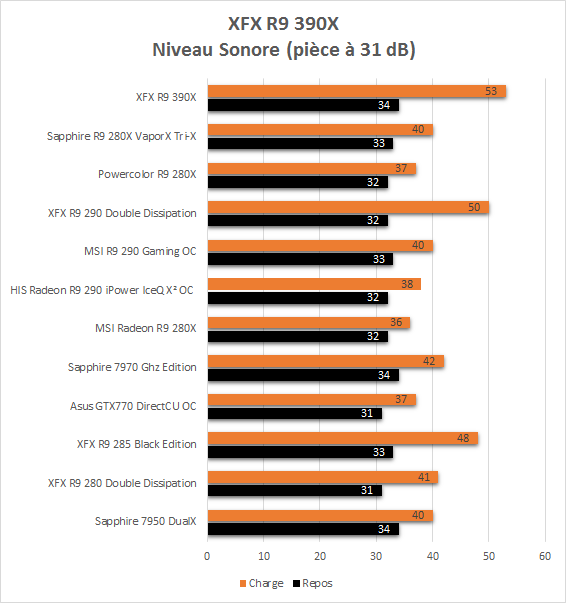
Indeed we have nothing for nothing, as usual with XFX the performance takes precedence over the noise generated, indeed with 53 dB the card is really noisy and will be clearly heard in a box and will be without too much s ” advance the main source of noise. However, this must be put into perspective because in game the card will heat up less than during an OCCT test, the sound level that you see here represents the worst case, when the card is pushed to its limits.
Powertune
To get started, let’s take a look at the Powertune that powers the XFX R9 390X. Powertune is responsible for maintaining the temperature of the processor, the consumption of the card below certain values. During overclocking it is mandatory to be able to modify all the possible settings in order to obtain the best performance, for Powertune and the R9 390X series it is possible to increase the consumption limit of the card by 50% (like the R9 290 / 290X).
Let’s see how the GPU reacts when subjected to OCCT:
Factory settings :

When we do not touch the consumption limit, Powertune brings the cards down to around 920 MHz, which is quite far from the supposed 1050 MHz but still remains within the reasonable domain. Let’s see what Powertune has to say when we unlock this consumption limit.
Consumption limit + 50% :

Powertune therefore only asked for a little more juice not to lower the frequencies of the card, the card remains around the original frequency, namely 1050 MHz.
What about when the card is subjected to something more representative of what might be asked for in a game, such as during a small 3DMark Fire Stike?
3DMark Fire Strike, factory settings :

The curve is quite different compared to what we observed during the OCCT test with the factory settings, in fact the card remains very close to 1050 MHz, without really being 100% of the time at this frequency, perhaps that the modification of the consumption limit will have an impact?
3DMark Fire Strike, consumption limit + 50% :

We can say that this is stable, the card remains at 1050MHz throughout the test, without batting an eyelid.
3DMark Fire Strike
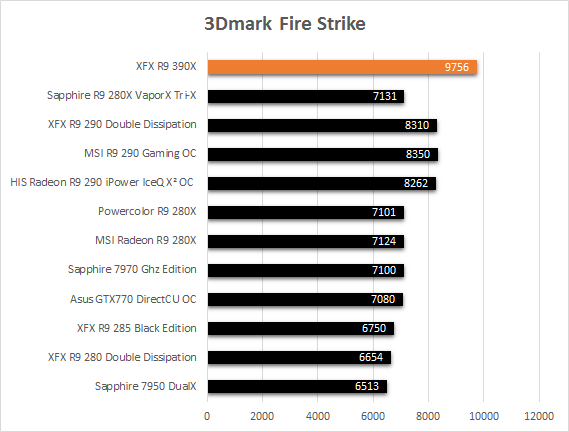
Battlefield 4
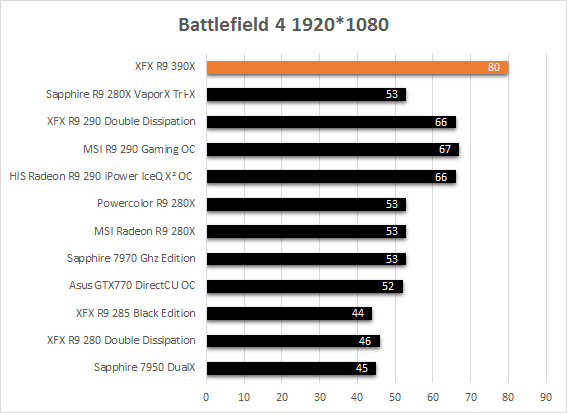
Bioshock Infinite
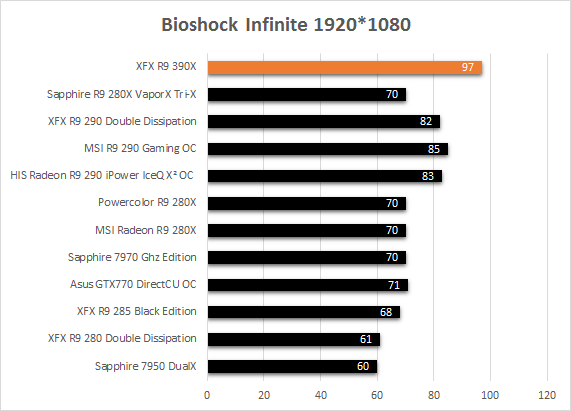
Crysis 3

Hitman Absolution
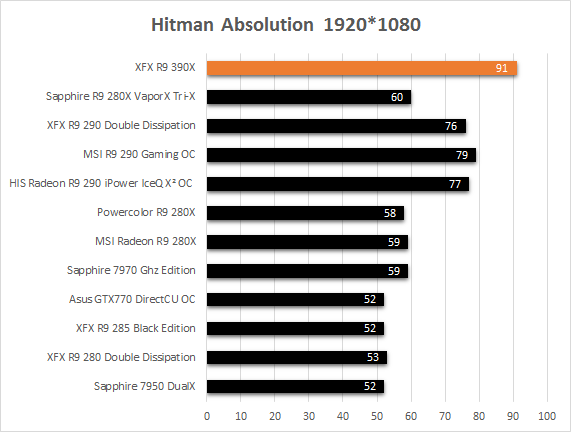
Tomb Raider

Summary of performance
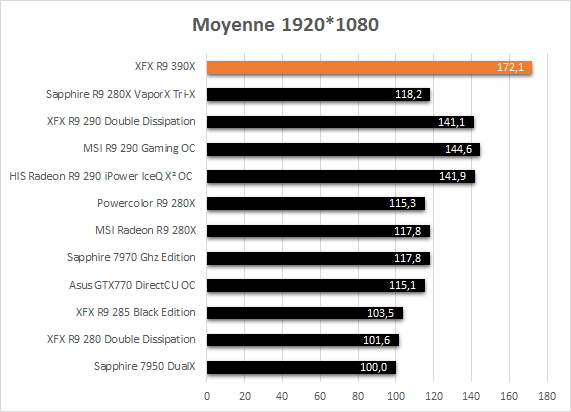
The performance is compared to a Sapphire HD7950 DualX, which has a base 100 :
As we can see the R9 390X puts in its place its little sister the R9 290 well as it should with a performance increase of more than 20% (70% more efficient than an H7950 / R9 280) in general (for models with cooler modified compared to the reference design), we can say that games in Full HD even with maximum details clearly do not scare the R9 390X!
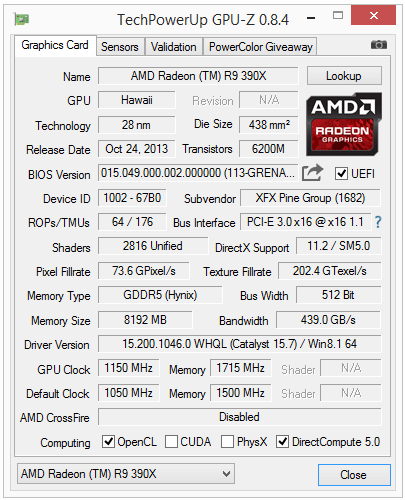
The maximum overclocking achieved, with the help of the 50% additional consumption is:
- GPU: 1150 Mhz (+100 Mhz)
- Memory : 1715 Mhz (+ 215 Mhz)
The cbez XFX R9 390X was rather docile in terms of memory overclocking, going from the original 1500 MHz to a large 1715 MHz (+ 14.3%) while the GPU went from 1050 MHz to 1150 MHz (+ 9%). Note that this overclocking was not done with any modification of the voltages, indeed even the original fans of the card were running at more than 100% (in PWM mode) therefore an increase in consumption and therefore heat to dispel would have been only counterproductive.
Consumption
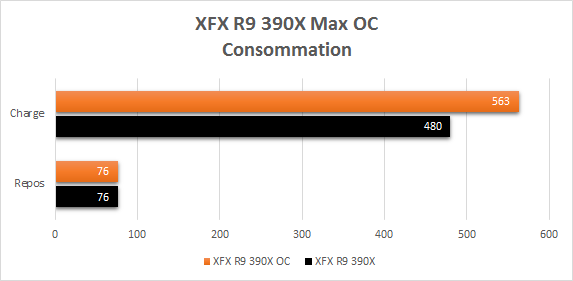
Ok here we start to type in the heavy consumption level, with 563 Watts taken, this is the highest reading I have had so far for a mono GPU configuration. Overclocking despite the absence of modification of the voltage increases the consumption by 83 Watts at the outlet, this is clearly not nothing and at this level it is better to have a power supply that holds the road if you use in such a way. intensive the card. By making an approximate calculation the card alone must exceed 350 Watts of consumption.
Having said that and once again this figure represents a case that will certainly never happen in a machine, except in benchmarks that use 100% of the processor and graphics card simultaneously.
Temperatures
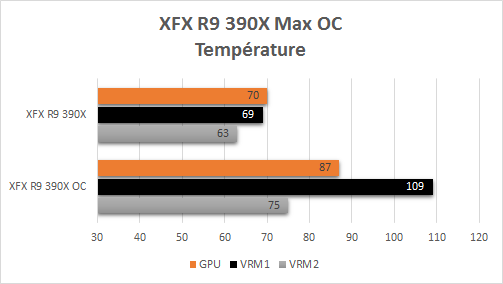
Originally as I said above, the cooling system holds the important components at very appreciable temperatures, 70 ° for the GPU and respectively 69 ° and 63 ° for the VRM1 and VRM2, so far no worries! Once the maximum overclocking is reached, however, the situation changes and the temperatures soar, 87 ° for the GPU, 109 ° and 75 ° for the VRM1 and VRM2. Even if these temperatures seem worrying they are not, but we are still approaching the limit not to be exceeded, especially at the level of the GPU and VRM1, an increase in the voltage is clearly not an alternative viable on the map, like a lot of maps of this type anyway unless you have full waterwooling for the beast.
Sound level
Warning: Part to be taken with a grain of salt, unfortunately not having access to the appropriate equipment and using an android application to take the readings The measurements below are only indicative! The readings were taken 20cm from the graphics card.
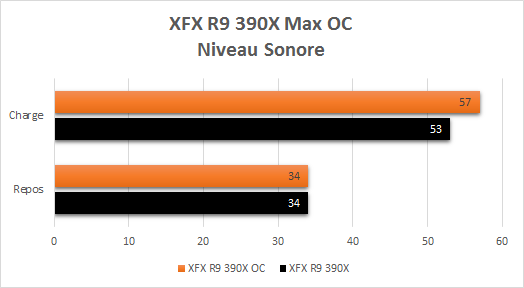
Well, the fans are running at 100% so the noise pollution increases further to reach 57 dB, which as you can imagine is quite unpleasant for the ears, you will have to have headphones and the sound loud enough not to be disturbed by the beast.
Powertune
What will our little Powertune say with the overclocking of the XFX R9 390X? Let’s see right away:

Powertune can’t find anything to say even under OCCT at maximum overclocking, at least a good thing 😉
Results
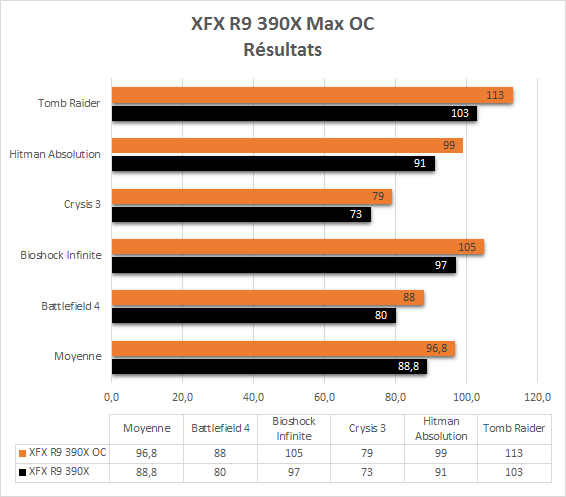
With the overclocking carried out, we obtain an average of about 9% more performance, which is a small increase without really changing the situation, especially since for 9% we have to deal with the inconvenience that goes with it (increase in temperatures, consumption and noise level).
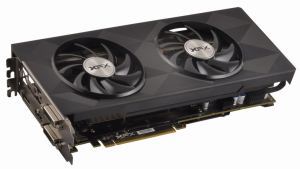
Here we are at the end of this test, what about the XFX R9 390X?
AMD has updated its R9 290 / 290X and shows that the platform is now well mastered, the R9 390X offers very good performance (at the level of a GTX980) and will clearly not lag behind the latter especially in 4K. The increase in frequencies compared to the R9 290X is not without consequences, it comes at the level of consumption which is enormous (especially in overclocking) and noise pollution with a cooler (even if very good) which must be blow turbiner to cool the card.
Price side we are around 485 € for the XFX R9 390X, even if it remains competitive against a GTX980 (in terms of performance) it is still 140 € more than some R9 290X (the Sapphire TriX for example), this the latter offers a much more interesting performance / price ratio while waiting for stocks to run out. Despite everything, do not understand that the XFX R9 390X is a bad card, far from it, it clearly has its place in a gamer config but it is in the shadow of its big sister the R9 290X as long as the prices have not been packed.
Advantages
- Performances
- Controlled platform
Disadvantages
- Consumption
- Noise
- Price compared to the R9 290X
A big thank you to Jérémie from Goldenfish who allowed me to do this test.















